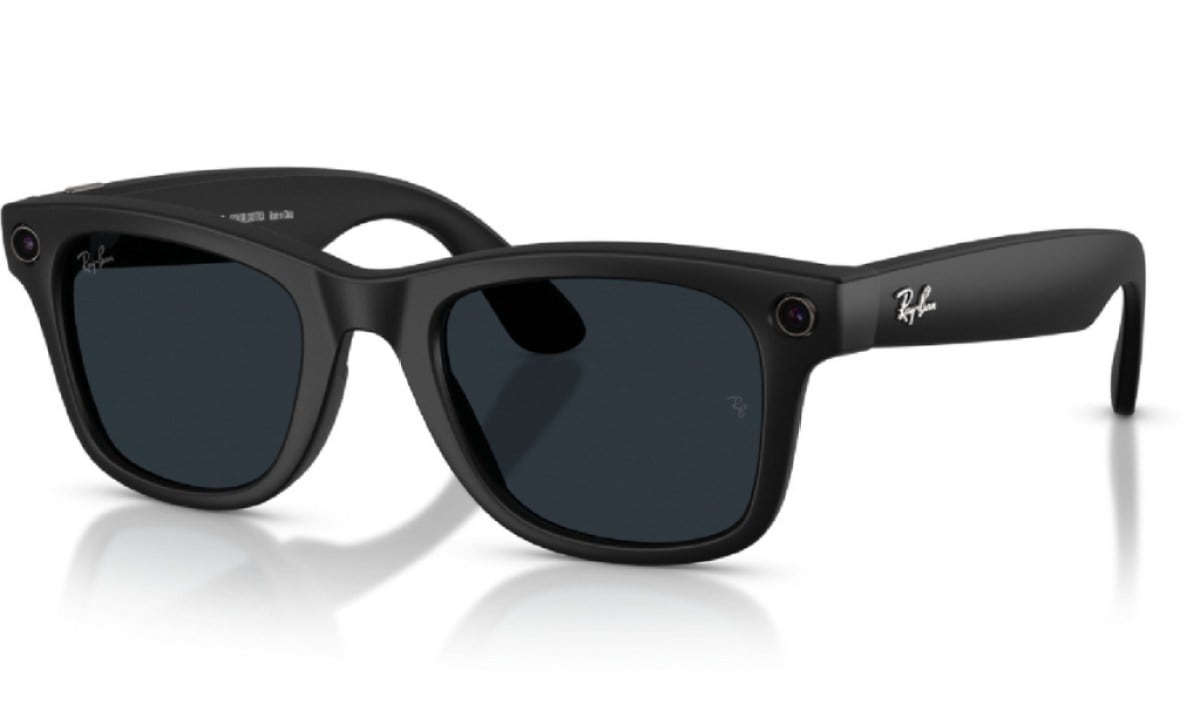In the age of wearable technology, there are myriad devices designed to help us track our steps, send hands-free messages and navigate trails. However, devices like the Meta AI Wayfarer Sunglasses from Ray-Ban provide a new level of hands-free functionality thanks to AI integration. Now available at REI Co-op, the Meta AI sunglasses provide a convenient and hands-free way to take calls, translate speech or text in six languages, answer questions, and capture life’s moments in video and still photos.

Key Features of the Ray-Ban Meta AI Wayfarer Sunglasses
The Meta AI Wayfarers are a form of wearable tech, like smart watches and heart rate monitors, that can track and interpret data about your body, location, environment and more. Meta (formerly Facebook) is a tech company that operates various social media platforms like Facebook and Instagram, and communications apps like WhatsApp. It recently expanded into wearable technology and has teamed up with premium eyewear brand Ray-Ban (and parent company EssilorLuxottica) to turn classic eyewear designs into smart glasses.
One of the Meta AI sunglasses’ biggest plus sides is that they’re hands-free, letting users navigate the world without grabbing their cellphones to complete basic tasks. For example, thanks to Bluetooth compatibility and a built-in microphone, camera and open-ear speakers, these AI glasses from Ray-Ban allow users to:
- Chat directly with Meta AI for calendar reminders and real-time answers to questions
- Converse in six different languages using live translation
- Capture photos and high-definition videos with the 12 megapixel camera
- Listen to music and podcasts through integrated open-ear speakers
- Send text messages and take phone calls hands-free
While these hands-free features are appealing for everyday use, I was especially curious about how the sunglasses might enhance my time on the trail. Would the sunglasses help me immerse myself in nature, or would they be a different kind of distraction?
Testing the Ray-Ban Meta AI Wayfarer Sunglasses
I’m an avid hiker based in the Pacific Northwest, and I cover hundreds of miles of trails every year. I recently spent a week testing the Ray-Ban Meta AI Wayfarer Sunglasses to see how they can enhance both hiking and everyday life. I tested the glasses for over 15 hours and wore them on some of my favorite Spokane hikes, while running errands and on neighborhood walks, in both rainy and sunny conditions. I used them to perform basic tasks (playing music, issuing reminders, checking the weather), and taking photos and videos. I also tested out the advanced AI features to learn more about the plants and ecology of my local trails.
Here are my thoughts on the Ray-Ban Meta AI Wayfarer Sunglasses.
| Pros | Cons |
|---|---|
| Lightweight and comfortable | Brimmed hats and bangs can obscure the camera |
| Charging case allows an additional 48 hours of battery life | Battery life not as suited for multiday or backpacking trips |
| Hands-free messaging | Film resolution a bit low for many social platforms |
| Open-ear speakers allow for more immersion in the natural world | Fixed focal-width photography means no zoom and landscape orientation only |
Best For
- Hikers who want to immerse themselves in nature while still being able to ask questions about their environment, record photos and videos and play music.
- Kayaking, cross-country skiing and other outdoor activities where you can’t easily hold a cellphone while performing the activity. The hands-free features are also extra nice in cold weather when you’re wearing gloves!
- Everyday wear for playing music, getting reminders and performing basic tasks. I also think these would be super fun to wear at concerts to stay in the moment while still capturing photos or videos!

Comfort and Protection
The first thing I noticed about these glasses was how lightweight and unobtrusive they felt on my face. For the most part, they look and feel like regular Ray-Ban Wayfarer glasses, which I’ve been wearing for over a decade. The Meta AI sunglasses weigh a hair more than a standard part of Wayfarers, despite the additional speaker, microphone and built-in headphones. Size-wise, the Meta AI Wayfarers are almost identical as well; the only difference is a negligible loss of lens height (40.6 mm in the AI version; 50 for the standard Wayfarers). Both sunglasses also offer 100% UV protection. And, the Meta AI sunglasses feature slightly lower visible light transmission (VLT): 11% compared with the standard sunglasses’ 13.2%. (Learn more about VLT in our Best Sunglasses gear guide.)
Battery Life and Charging
These glasses boast an impressive 8-hour battery life, making them appropriate for all-day wear. The glasses can get an additional 48 additional hours of use time with a fully charged glasses case. All I had to do to recharge them was to place them in the case. You can power the glasses up to 50% in just 20 minutes.
I found the glasses case to be easy and relatively fast to recharge. However, the glasses don’t come with a charging cord, so users must purchase a USB-C cable separately. The glasses charging case is a bit heavy, so I likely wouldn’t bring the case itself along with me for day hikes or backpacking trips. As such, I think these glasses are best-suited for day hikes under 8 hours.
Audio and Video
The Ray-Ban Meta AI Wayfarer Sunglasses have a range of features that can enhance the hiking and outdoor recreation experience, while also providing powerful AI-driven tools to assist with everyday life and travel. However, as an avid photographer I was most excited to see how they would perform capturing photos and videos. Hands-free photography and filming have a lot of appeal for staying in the moment and remaining better engaged with my environment, and I wanted to see how these glasses stacked up against my iPhone and professional Canon camera.
The sunglasses house an ultrawide 12 MP camera with slow motion, hyperlapse and dynamic photo capabilities, and 32 gigabytes of storage, making them a great option for capturing images and videos on the go. However, I do wish that these glasses came with the ability to film in 4K, which is generally the preferred resolution for social media platforms. Additionally, these glasses only have the ability to capture photos and videos vertically.
Overall, I was impressed with the video and image quality produced by the Meta AI Wayfarers. I was able to seamlessly capture photos and videos on my hikes, and I loved not having to pull out my phone or bulky professional camera. I could capture photos by tapping the small button on my temple, or with the voice command, “Hey, Meta, take a picture.” For videos, I could start recording by holding the same button on my temple, or by saying, “Hey, Meta, record a video.”
I found the colors and quality of the footage to be vibrant and true-to-life. However, the wide angle took some getting used to, and if you wear a cap while hiking it might appear in your footage unless you push the brim up. The camera of this model has a fixed focal length, meaning you cannot zoom in or out. The camera won’t replace my professional setup for closeups and detail shots, but the Meta AI Wayfarers’ images are more than good enough for most uses. I was especially impressed by the video quality and how easily I could capture “point of view” footage that immerses the viewer in the scene.
It’s worth noting that, although the wearable technology aspects of the glasses are discrete, they do light up to let others know when the glasses are being used to record video or photos.


A side-by-side comparison of images taken with the Ray-Ban Meta AI Wayfarer Sunglasses (right, cropped) and with a professional Canon R6 camera (left). Photo credit: Gwyneth Manser
I also loved being able to play music through the glasses’ high-quality built-in speakers. I often hike with Shokz bone-conducting headphones since they allow me to stay attuned to ambient noises in my surroundings. The Ray-Ban Meta AI sunglasses’ open-ear speakers provide a similar experience, and I easily adjusted the volume using controls on the temples. There is some noise bleed if you’re listening at higher volumes, but music, podcast and phone conversations aren’t detectable when kept lower.
The speakers and embedded microphone also let me send text messages and look up information while on the trail. My Meta AI sunglasses read my incoming messages and reminders straight from my phone, thanks to Bluetooth connection. They were also able to tell me the weather and other useful information. All I had to do was say, “Hey, Meta,” and ask my question. These features were useful on hikes, and while driving and running errands. The glasses also have a surprisingly robust and accurate language translation feature, which I could see being invaluable for international travel. I’m a rusty Spanish speaker and, while I’m not fluent, I was able to verify the translation accuracy of several basic phrases while wearing the glasses.
AI Assist
By far my favorite feature was my Meta AI sunglasses’ ability to interact with and interpret the world around me. I used my glasses to identify plants and animals on hikes and to learn about my local Pacific Northwest trails’ geology and ecology. It felt a little like having a naturalist along with me. Being able to use this feature hands-free made me feel more immersed in nature and in the moment. Instead of pulling out my phone, using an app to identify a plant, and then reading a webpage about the plant, I could have Meta AI read that information to me. That meant I stayed active and engaged in the moment while enjoying the outdoors.
Downsides to the Ray-Ban Meta AI Wayfarer Sunglasses
The Ray-Ban Meta AI Wayfarer sunglasses are powerful tools, but they’re not right for everyone. If your goal is to escape technology while you’re recreating outside—maybe you prefer guidebooks over apps and a camera that isn’t built into your phone—these glasses might not be the best option for you. Similar to smartwatches, this wearable technology integrates features like text messaging and the internet into your everyday life, making it harder to disconnect.
Additionally, these glasses do have some limitations. More advanced models of Ray-Ban Meta AI glasses come with integrated screens, but the model I tested (the Wayfarer Gen 2) lacked these premium features. As a hiker, having an integrated screen to help me stay on the trail holds strong appeal and would make these glasses more useful for outdoor recreation. Finally, this might be a niche problem, but I have curtain bangs. Something I didn’t anticipate was the way my hair would often obscure the camera and video lens on the glasses. At times, this made the glasses difficult to use.
Bottom line
The Ray-Ban Meta AI Wayfarer Sunglasses are a powerful tool that can be used for outdoor recreation, travel and everyday life. Comfortable, intuitive and easy to use, these glasses have an impressive array of features that help you capture hands-free images and video, interact with the world around you and perform tasks like playing music, looking up information and sending text messages.
As someone who wants the ability to identify plants, snap photos and occasionally listen to music on the trail, I’m pleased to report that overall, these glasses enhanced my experience of the natural world by providing me a single, hands-free device to do it all without staring at a screen or toggling among apps. I think these glasses offer a powerful suite of tools that can be especially helpful for outdoor enthusiasts and travelers.
